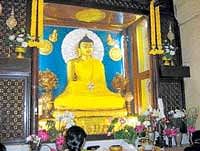Where the Buddhists converge

On the chilly winter morning of December 8, around 5,000 Buddhists monks from across the world, attired in their traditional maroon robes, lined up in Bodh Gaya to attend the ceremony commemorating the 900th anniversary celebrations of the first Karmapa - Dusum Khenpyo, who founded the Kagyu Buddhist sect.
Earlier, this year, the head of Tibetan Government in exile, the Dalai Lama delivered a special sermon at Kalchakra Maidan in Bodh Gaya where his celebrity follower and Hollywood mega star Richard Gere sat like an ordinary acolyte, listening to the preachings of the spiritual head of Tibetan Buddhists in rapt attention.
On November 13, the Crown Prince of Thailand, Maha Vajiralongkorn landed a Boeing 737-400, the special pilgrimage flight from Bangkok, at Gaya International Airport. The Prince, a trained pilot, was in Bodh Gaya along with Princess Srirasmi and her children Bajrakitiyabha (26) and Dipangkorn (6).
So what makes Buddhists from across the world to fly down to a small place like Bodh Gaya? Simple. It is the place where Buddha attained Enlightenment.
Far from the madding crowd of Patna, around 25,000 tourists, from Japan, China, Sri Lanka and Thailand and other countries visit the Holy town every day and offer prayers, chant and meditate on the premises of Mahabodhi Mahavihara, the most sacred temple for Buddhists.
This is the holy place where 2550 years ago, a young Sakya Prince, Siddhartha Gautama renounced his royal heritage, and came to in his search for The Truth. Bodh Gaya was where he was looking for a quiet retreat where he could meditate upon the causes for human suffering. In 6th century BC, Siddhartha attained Supreme Enlightenment and since then has been known as Buddha, founding one of the world’s greatest religions.
In his commemoration, Emperor Ashoka set up a Vajrasana (diamond throne) of polished sandstone representing the Seat of Enlightenment in the 3rd century BC. Thereafter, he built a stupa in veneration of Buddha, which remained there up to 2nd century AD.
The original structure of Mahabodhi Mahavihara Temple was completed during the reign of Gupta kings in the 7th century AD. The temple underwent several restorations, renovations and repairs in subsequent periods in which the Burmese contributed immensely.
The role of the British
In 1883, a thorough and scientific renovation of the temple was conducted under the supervision of British Archaeologist Sir A Cunningham and J D M Beglar and the Indian archaeologist Dr Rajendra Lal Mitra. Set among lush green lawns, the giant pyramidal sandstone structure soars to a height of 54 metres and is visible for miles around. The walls are carved with various aspects of Buddhism. The sanctum sanctorum has a colossal golden Buddha. A chamber at the top houses a figure of Mayadevi, the Buddha’s mother. An ancient stone railing surrounds the temple on three sides. The railing, which dates to more than 2,500 years ago, is the oldest of the excavated evidence in Bodh Gaya.
The temple, originally built by Emperor Ashoka in 3rd century BC, was re-built in the 7th century by Pala Kings of Bengal. Renowned Chinese scholar pilgrim Hieun Tsang visited it. Destroyed by Muslim invaders in the 12th century, the temple was restored by the Burmese kings in the 14th century. It was eventually declared a World Heritage Site by UNESCO on June 27, 2002.
Barely 115 km from Patna, the land of Buddha is rich, fertile and dotted with green fields because of river Phalgu, which, in ancient times, was known as Nairanjana, after Lord Buddha, having attained Enlightenment, bathed in it.
Bodhi tree
To the left of the Mahabodhi temple is the sacred Bodhi tree under which Siddhartha Gautama meditated and attained Enlightenment on the full moon day of Baisakh Purnima (the month of May). The peepal tree’s botanical name is Ficus Religiosa. Buddha spent
under the treee the first week in meditation after attaining enlightenment.
The present tree is probably the fifth successor of the original tree, which was earlier destroyed several times by man-made and natural calamities. It is said that the present tree grew from a sapling brought from the tree in Anuradhapura in Sri Lanka, which had been planted by Emperor Ashoka’s son Mahendra in 3rd century BC. The holy tree, which is surrounded by small beautifully carved votive stupas and chaityas, form a canopy over the seven sacred shrines. People pray, meditate and prostrate before the Bodhi tree, making a wish. Or simply bow for thanks-giving.